Main Menu
Homepage / Backcountry Awareness / Backcountry Awareness: What to Carry
Backcountry Awareness: What to Carry

Gina has always been stubborn and bold, so when it came to advocating for women’s rights and equality in the outdoors, she was bound to make changes. As the founder of Trail Sisters, Gina’s goal is to grow participation and opportunity in women’s trail running. Gina is also Mayor Pro Tem for the town of Buena Vista, Colorado, an active member and former Training Director of Chaffee County Search & Rescue, and Race Director for the Lake Sonoma 50 Mile, Marathon, and Trail Sisters Half Marathon.
Share This Article!
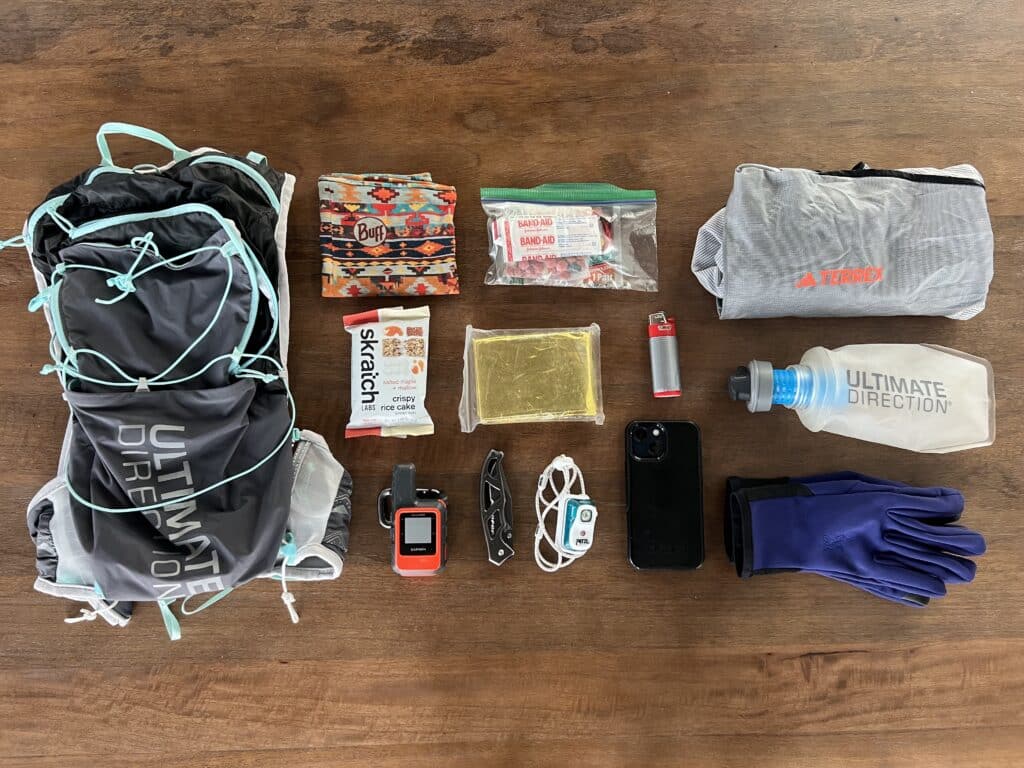

By: Gina Lucrezi
There are select pieces of gear that should be included in your pack for all and any adventures. Additional items will be dependent on the amount of time you plan to spend outside, location, terrain, weather, distance, and temperature.
Whether you are adventuring in the front country or the backcountry can also affect gear choices.
Front country can be defined as a non-remote, recreational area near a population center that is accessible by motorized vehicles.
Backcountry can be defined as a remote area, far from population centers and resources, and is generally inaccessible to motorized vehicles.
With all this said, you should always consider taking extra precautions and supplies. It makes for a heavier load, but you’ll be happy to have helpful gear if you (or someone else you encounter) need it. Having the right items in an emergency situation can ultimately save your life.
It’s easy to plan for the expected, but it’s best to prepare for the unexpected!
Below are four categories of gear recommendations based on temperature, location and accessibility.
- Warm Weather – Front Country
- Warm Weather – Backcountry
- Cold Weather – Front Country
- Cold Weather – Backcountry
Warm Weather – Front Country
Below is a list of suggestions for what to carry when you are adventuring in the front county. An example of a front country adventure would be a 3-5 mile run or hike from a trailhead on the perimeter of town (or within town). There may even be vehicle access points throughout this trail system or recreational area. If someone would become injured and non-ambulatory or lost, there is a high possibility of being found or assisted by others on trail, or quick assistance by local authorities and vehicles.
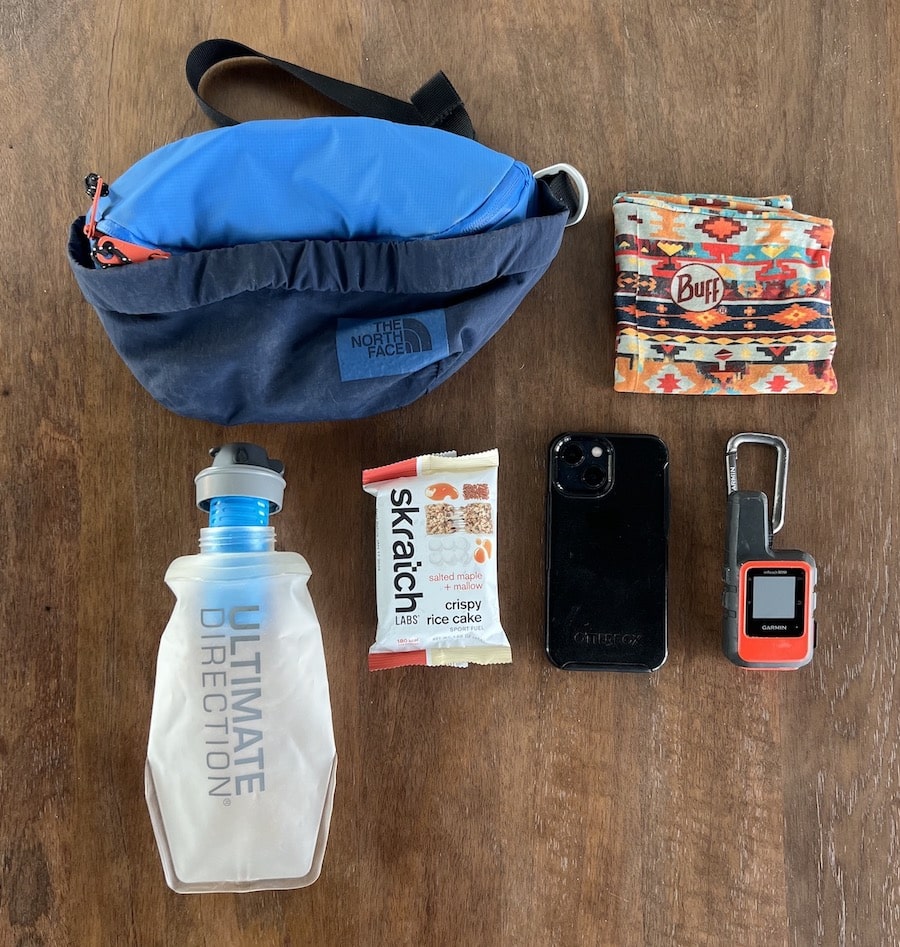
Essential Items:
- Cell Phone – Call for help, mapping abilities, etc.
- Filter Flask – Allows clean and quick access to any water source.
- Food – Energy and calories.
- Head Covering/Hat – Hat with brim protects skin from the sun and shades eyes.
- Personal Locator Device (PLB) – Ability to signal (and communicate) for help. Tracks location and movement which is valuable for rescuers, whether an SOS is activated or not (if unconscious for example).
Warm Weather – Backcountry
Whenever you are in the backcountry always prepare for an unexpected situation. It’s a primitive space without access to common forms of support. Therefore you will need to be creative with the resources you have…so make sure you’ve packed them!
When in the backcountry always consider the possibility of an overnight stay. If lost or injured and cannot make it to shelter in the daylight, you will have to brave the night. The goal is to stay warm and dry. It will likely be uncomfortable without much sleep, but surviving is your main focus.
When recreating in warm weather temperatures you don’t need to carry as much apparel to keep your body temperature at a happy homeostasis. Mid-day and afternoon hours are the hottest part of the day so you will be doing what you can to stay cool. As the sun sets, temperatures quickly cool off in the backcountry (especially in the mountains), and those extra layers you’ve lugged around will come in handy.
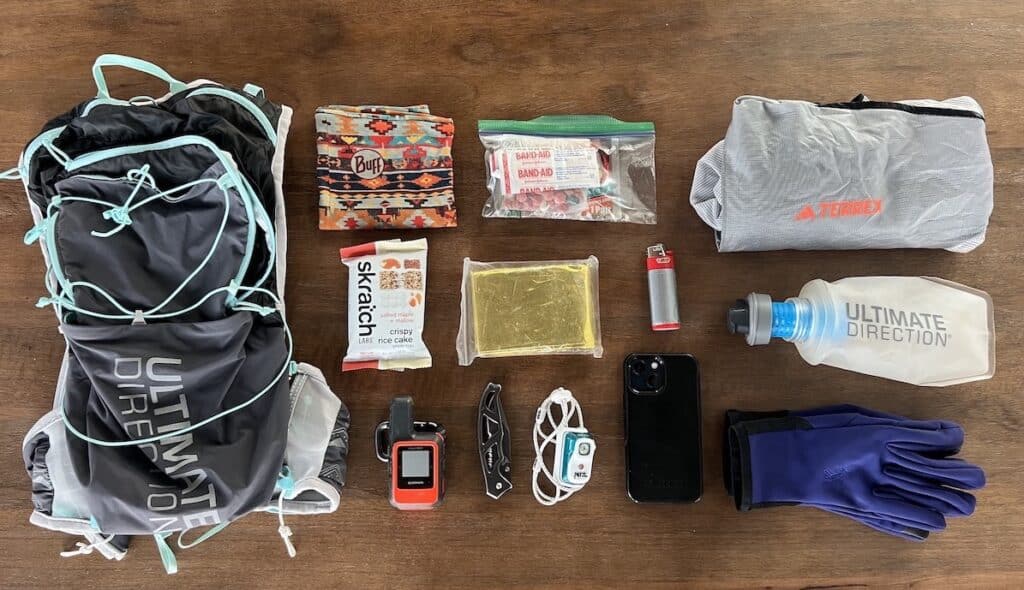
Essential Items:
- Cell Phone – Call for help, mapping abilities, etc.
- Filter Flask – Allows clean and quick access to any water source.
- Food – Energy and calories.
- Head Covering/Hat – Hat with brim protects skin from the sun and shades eyes. Buffs can provide cooling (soak in water), or help retain warmth.
- Personal Locator Device (PLB) – Ability to signal (and communicate) for help. Tracks location and movement which is valuable for rescuers, whether an SOS is activated or not (if unconscious for example).
- Personal Med Kit – Band-Aids, NSAIDs, Antiseptic Wipes, Antibiotic Ointment, Chemical Hand Warmers, and any other preferred items.
- Lightweight Jacket – Wind or waterproof jacket will shield against an unexpected storm and its elements, and also helps retrain heat.
- Lighter – Lightweight and small. The ability to create a fire can help with warmth, signaling, cooking food, boiling water, warding off wildlife & bugs, illumination, etc.
- Headlamp – Reliable illumination in the dark, and a good location attractor (search purposes).
- Knife – Various purposes.
- Duct Tape – Various purposes. Carry 1-2 feet and wrap around lighter, poles, water bottle, etc.
- Light Weight Gloves – Though it’s warm during the day, the night may be chilly. Keeping your hands warm and functional adds to overall comfort.
- Space Blanket – Small, light weight, cheap. Keeps you warm, aid in visual signaling (reflective material), and various other uses. *Any space blanket will do, but the blankets constructed as a bag are best.
Cold Weather – Front Country
Since front country adventures take place closer to populated areas with vehicle and varied trail access, packing needs can be moderate, but not minimal. Cold weather creates a more precarious environment, elevating an emergency situation to critical. Extended exposure to the elements and cold temperatures may cause a life-threatening outcome, so it’s highly important to carry extra items in case of an emergency. Pack what you’d need to help retain warmth for an extended amount of hours before help arrives. Front country rescue situations generally resolve in a much shorter time frame compared to backcountry because of the access to supportive resources.
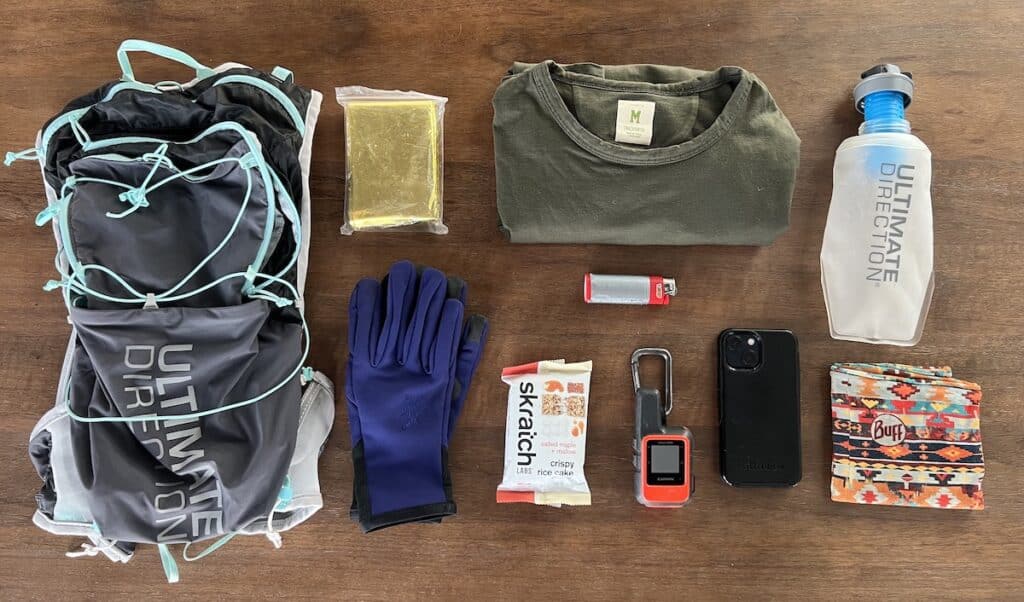
Essential Items:
- Cell Phone – Call for help, mapping abilities, etc.
- Filter Flask – Allows clean and quick access to any water source. *Keep insulated to protect from freezing.
- Food – Energy and calories.
- Lighter – Lightweight and small. The ability to create a fire can help with warmth, signaling, cooking food, boiling water, warding off wildlife & bugs, illumination, etc.
- Head Covering/Buff – A beanie will keep your head warm (you lose most of your heat through your head and feet). A Buff can serve as a “beanie” and a face & neck protector.
- Extra Gloves – Keeping your hands warm and functional adds to overall comfort.
- Extra Layer – Preferably wool, this layer is handy to swap when wet/damp, or simply an additional layer.
- Space Blanket – Small, light weight, cheap. Keeps you warm, aid in visual signaling (reflective material), and various other uses. *Any space blanket will do, but the blankets constructed as a bag are best.
- Personal Locator Device (PLB) – Ability to signal (and communicate) for help. Tracks location and movement which is valuable for rescuers, whether an SOS is activated or not (if unconscious for example).
Cold Weather – Backcountry
Adventuring in the backcountry during cold weather conditions requires lots of gear needs and considerations. A winter wonderland is fun to explore and enjoy, but it can be a ruthless beast if you’re not prepared in an emergency situation. Harsh conditions require a more conservative approach, as their effects are compounded in severity and with a shorter time window for help. Always pack gear that would allow you to survive and unexpected night outside, as it’s likely help won’t reach you before the sun goes down (or until the next day in bad weather). You are you best advocate for survival in remote locations (especially winter conditions), so it’s very important to pack with that in mind. High stakes situations require extra attention to detail and preparation.
Below is a list of must-haves, but additional items to consider based on conditions may include: traction (micro-spikes), flotation (skis or snowshoes), ice axe (self arrest), avalanche gear (shovel, probe, beacon), etc.
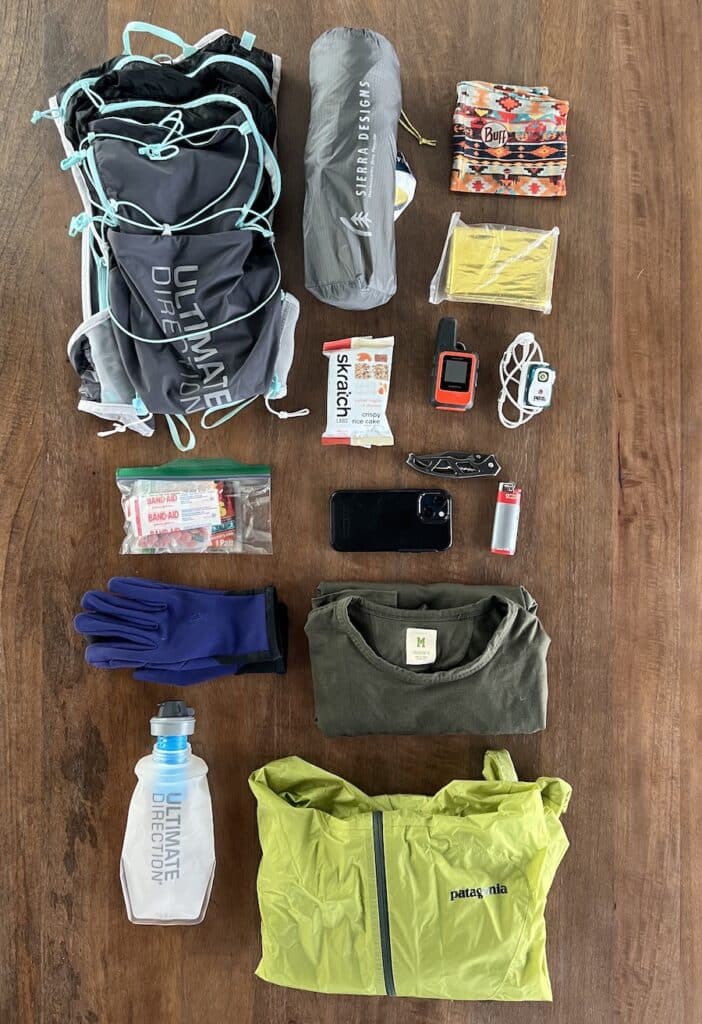
Essential Items:
- Cell Phone – Call for help, mapping abilities, etc.
- Filter Flask – Allows clean and quick access to any water source. *Keep insulated to protect from freezing.
- Food – Energy and calories.
- Lighter – Lightweight and small. The ability to create a fire can help with warmth, signaling, cooking food, boiling water, warding off wildlife & bugs, illumination, etc.
- Personal Med Kit – Band-Aids, NSAIDs, Antiseptic Wipes, Antibiotic Ointment, Chemical Hand Warmers, and any other preferred items.
- Head Covering/Buff – A beanie will keep your head warm (you lose most of your heat through your head and feet). A Buff can serve as a “beanie” and a face & neck protector.
- Extra Gloves – Keeping your hands warm and functional adds to overall comfort.
- Extra Layer – Preferably wool, this layer is handy to swap when wet/damp, or simply an additional layer.
- Bivy – Compact, fairly light weight, insulated shelter bag. An emergency bivy may save your life, as it’s the next best thing to a tent and sleeping bag.
- Space Blanket – Small, light weight, cheap. Keeps you warm, aids in visual signaling (reflective material), and various other uses. A space blanket is NOT a substitute for a bivy. Pack both!
- Personal Locator Device (PLB) – Ability to signal (and communicate) for help. Tracks location and movement which is valuable for rescuers, whether an SOS is activated or not (if unconscious for example).
- Waterproof Jacket – Armor to protect from the elements, hold heat, and act as a shelter.
- Headlamp – Reliable illumination in the dark, and a good location attractor (search purposes).
- Knife – Various purposes.
- Duct Tape – Various purposes. Duct Tape – Various purposes. Carry 1-2 feet and wrap around lighter, poles, water bottle, etc.
About the Author

Gina has always been stubborn and bold, so when it came to advocating for women’s rights and equality in the outdoors, she was bound to make changes. As the founder of Trail Sisters, Gina’s goal is to grow participation and opportunity in women’s trail running. Gina is also Mayor Pro Tem for the town of Buena Vista, Colorado, an active member and former Training Director of Chaffee County Search & Rescue, and Race Director for the Lake Sonoma 50 Mile, Marathon, and Trail Sisters Half Marathon.
Share This Article!












